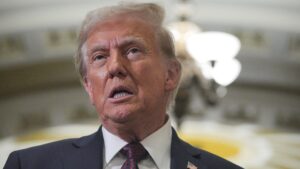—
## Will History Repeat Itself? Insights on Market Trends in the Wake of Trump’s Second Term
As we navigate the uncertainty of a new political landscape, financial analysts and investors are observing patterns reminiscent of 2017. Following the recent presidential election, market sentiments are notably bullish, echoing the early days of Donald Trump’s first term. The S&P 500 has already jumped approximately 4%, with a striking 2.9% uptick in just one week. However, many are questioning whether this initial momentum can sustain itself amid potential challenges like tariffs, regulatory shifts, and the end of the recent interest rate cut cycle.
### Analyzing the First 100 Days: Lessons from the Past
In 2017, the first 100 days of Trump’s presidency witnessed all major U.S. indexes soaring: the S&P 500 gained 5.3%, the Dow rose 6.1%, and the tech-heavy Nasdaq surged an impressive 9.2%. Fast forward to today, and financial experts, including Jeff Kilburg of KKM Financial and Art Hogan from B. Riley Wealth Management, suggest that while initial bullishness may continue, it is unlikely that we will experience another meteoric rise anytime soon.
“Given that we’ve just seen two consecutive years of nearly 25% returns on the S&P 500, it’s challenging to expect repeating substantial rallies without a boost in consumer confidence and company profits,” Kilburg points out. Indeed, investors appear to be taking a cautious “wait-and-see” approach as they assess how the new administration will unfold.
### Sector Performance: Energy on the Rise
One of the standout sectors currently is energy, which has outperformed most others, gaining 9.2%, while technology has seen a slight decline of 0.2%. This shift could potentially signal a long-term rotation away from tech dominance. “Energy is trading at reasonable multiples and offering attractive dividends, making it one of the better-performing sectors going forward,” suggests Hogan.
In contrast, many experts, including Kilburg, foresee a struggle for tech as the market may be due for some repricing following extraordinary growth during the COVID pandemic. While artificial intelligence continues to drive interest, we may not see the same explosive growth rates going forward.
### Watch Out for Crude Oil: Potential Price Upsurge
While crude oil demonstrated volatility during the early Trump presidency, it appears that this time, we could witness rising prices. “If Trump can maintain stability in the Middle East, we’re likely to see oil prices increase,” Kilburg speculates. With both West Texas Intermediate (WTI) and Brent crude futures already up over 8% in recent months, some investors are optimistic about continued growth in this sector.
### Gold and Bitcoin: Safe Harbors Amid Uncertainty
History suggests that gold often shines in uncertain political times, and experts believe that the precious metal may yet again serve as a safe haven. “Geopolitical tensions and inflation worries might propel gold prices up,” claims Kilburg. On a similar note, while Hogan sees a crypto-friendly administration potentially boosting Bitcoin’s acceptance, he warns that its growth may not be straightforward.
Kilburg argues that without significant governmental backing in the early days of the new term, Bitcoin could see a pullback. “Historically, it’s a matter of ‘buy the rumor, sell the news,'” he cautions.
### Currency Dynamics: The Future of the Dollar
The dollar has shown resilience, climbing against other major currencies since the election. However, as both Hogan and chief investment officer Peter Boockvar point out, this rally may be short-lived. With indications that the administration may prefer a weaker dollar and potential economic slowdowns on the horizon, investors should closely monitor its trajectory.
### The Bond Market: What’s Next for Treasury Yields?
Finally, the bond market reflects escalating yields. Currently, the 2-year Treasury yield hovers around 4.283%, while the 10-year yield stands at 4.623%. Experts predict that these yields may experience volatility as they respond to Federal Reserve policies and overall economic conditions. Kilburg suggests that there could be temporary hikes above 5% for long-term bonds before settling back around 4.5% following institutional repositioning.
### Conclusion: Navigating a Complex Landscape
The landscape is undeniably complex as we stand at the threshold of a new chapter with the Trump administration. While certain asset classes may reflect patterns seen in 2017, approaching this market with caution and a keen eye for emerging trends is crucial. Here at Extreme Investor Network, we advocate for thorough research and strategic planning to capitalize on current opportunities while mitigating risks.
Stay tuned for more insights from our expert analysts as we continue to unpack the intricacies of market dynamics in this ever-evolving environment.
—
This blog format enriches the content with analysis, insights, and actionable advice, setting it apart from other sources and providing value to our readers at Extreme Investor Network.

